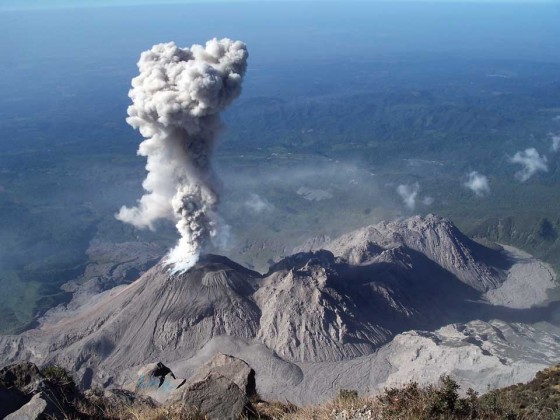Santiaguito

Santiaguito consists of four domes (from left to right): El Caliente (erupts 10-20 times daily), La Mitad, El Monje, El Brujo (photo: R.W. Sanderson)
Volcanic offshoot beckons trekkers to the Highlands
A mere infant in geologic time, the Santiaguito lava dome is a steam- spewing, smoke-belching spectacle
just outside Quetzaltenango in Guatemala’s Western Highlands.
Rising more than 8,000 feet above sea level, Santiaguito (Little St. James) is one of the world’s most active lava-dome com- plexes, consisting of several jagged peaks that have been forming in the aftermath of the catastrophic eruption of adjacent Volcan Santa Maria over a century ago.
Santa Maria, a 12,375-foot, roughly 30,000-year-old volcano, had been dormant for at least 500 years, if not several thousand, before a 10-month series of earthquakes signaled impending volcanic activity. On Oct. 25, 1902, Santa Maria erupted with such force that its volcanic ash reached San Francisco, California, some 2,500 miles away.
The disaster killed at least 5,000 people– a widely acknowledged underestimate–and more victims perished in a malaria outbreak that followed. Santa Maria ranks with Novarupta (Alaska, 1912) and Mount Pinatubo (Philippines, 1991) as one of the most violent eruptions of the 20th century.
Rising since 1922 in Santa Maria’s aftermath, the Santiaguito moonscape consists of four domes: El Caliente, the largest and most active with frequent eruptions; La Mitad; El Monje; and El Brujo.
Today, Santa Maria’s forested slopes provide a tranquil overlook of the noisy offspring, a popular destination for trekkers to get a close-up view of one of Guatemala’s most amazing sights.
For my recent visit, Adrenalina Tours arranged for lodging at the Villa de Don Andres, a quaint and cozy bed and breakfast just a block from Quetzaltenango’s Central Park.
Since clouds roll over the mountains by late morning, the day began with a 5 a.m. pickup for the half-hour drive to Llano del Pinal, a pueblo at the foot of Santa Maria. Edgar, a knowledge- able young guide from a local indigenous family, led the way in the morning fog.
Through fields of corn, potatoes, beans, onions, flowers and more, the trail rose along the base of Santa Maria. Occasionally, workers equipped with machetes, shovels and hoes walked or rode by on horseback to farm fields on the slopes.
Prominent on the horizon was the Siete Orejas (Seven Ears), a volcano with seven peaks that are said to resemble ears.
It took about two hours to reach the mirador, at an altitude of about 1,300 feet, providing breathtaking views of the Santiaguito siblings in a rocky, gray cluster, only a half mile away.
For more adventurous travelers, a two-day, overnight trek leads to a much higher outlook on Santa Maria, actually looking down at El Caliente, which erupts 10-20 times daily in addition to emitting constant towers of steam.
Though scenic, the destination is rated dangerous by volcanologists because of its high possibility of life-threatening eruptions–and with good reason. Violent eruptions in the 1980s and ’90s created dense mudflows in rivers below that leveled the nearby village of El Palamar and killed hundreds of residents.
Even so, adventure-seeking travelers from around the world are drawn to the site to marvel in its power and splendor.
For Quetzaltenango and the Highlands travel information, package tours and more visit www.adrenalinatours.com or your local tour operator.